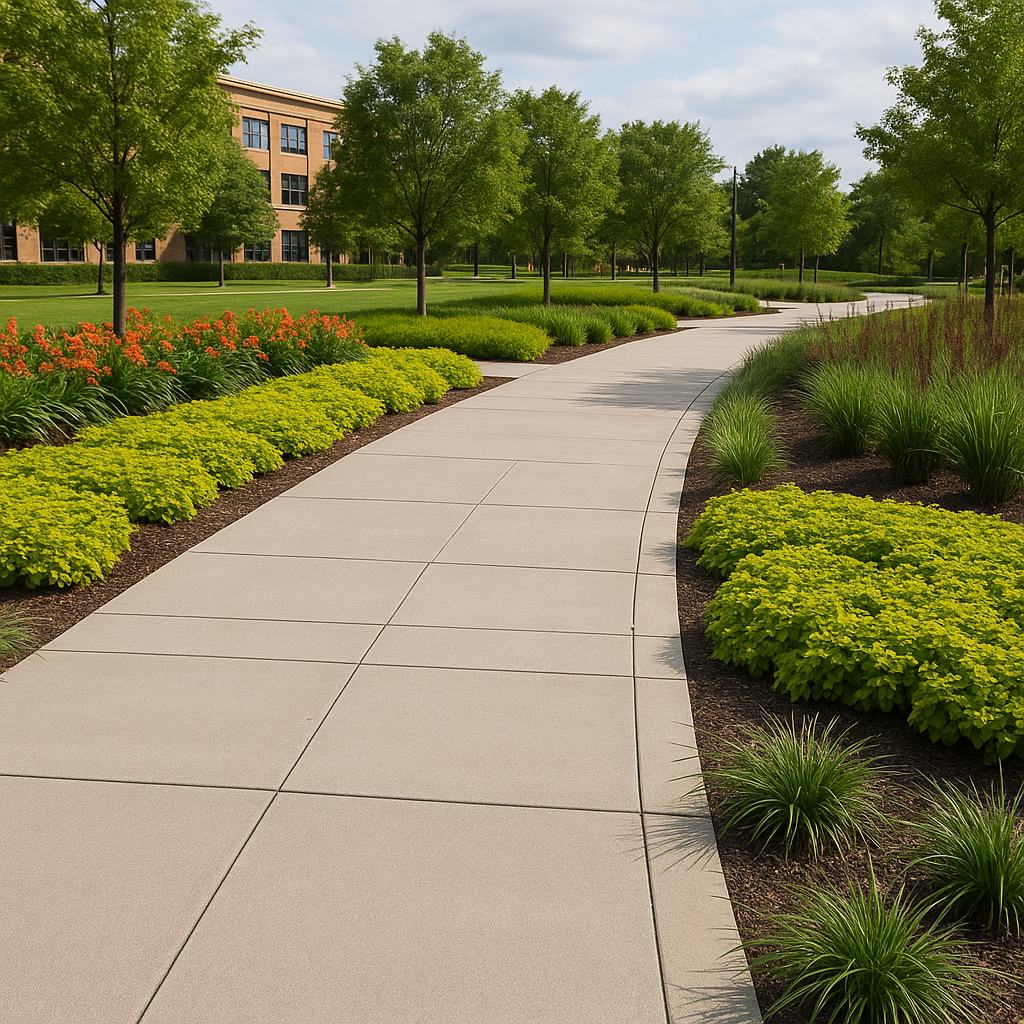In urban centers, campuses, commercial corridors, and transit hubs, outdoor environments must be more than decorative. They must withstand foot traffic, promote flow, and retain beauty throughout seasonal and daily use. A beautiful landscape designed for high-traffic areas merges durability with design sophistication, blending aesthetic value with long-term performance.
This guide explains how to approach landscape design architecture for high-use spaces by incorporating expert planning, appropriate materials, sustainable strategies, and thoughtful zoning.
Why High-Traffic Areas Deserve Beautiful Landscapes
Functionality Without Sacrificing Style
Crowded walkways and gathering zones often become purely utilitarian. A well-executed beautiful landscape elevates the experience without diminishing function, supporting usability, comfort, and visual satisfaction.
Enhances Property Value and Public Perception
Whether it’s a shopping center or university quad, first impressions matter. Durable green spaces with attractive finishes reflect professionalism and investment, improving reputations and increasing property value.
Reduces Maintenance Costs Over Time
Designing for wear from the outset prevents premature repairs and replacements. Sustainable, site-specific design minimizes the need for constant upkeep.
Explore related strategies in Beautiful Landscape Balancing Greenery and Usability.
Key Landscape Design Strategies for High-Traffic Environments
Landscape Drawing with Traffic Flow Analysis
An accurate landscape drawing should map primary circulation paths, desire lines, pause points, and bottlenecks. Planning for expected movement ensures surfaces remain intact and vegetation undisturbed.
Durable Hardscaping Materials
Use robust, weather- and traffic-resistant materials, such as:
- Interlocking concrete pavers
- Stone slabs with sealed joints
- Textured granite or sandstone
- Compacted crushed stone with edging
These provide longevity while aligning with aesthetic goals.
Modular and Replaceable Components
Paving units, planter boxes, and lighting fixtures designed for quick replacement reduce disruption and maintain continuous use.
Strategic Planting Zones
Group greenery away from heavy traffic areas, using:
- Raised planters
- Structural tree grates
- Buffer beds with ornamental grasses
This keeps foliage protected while softening hard surfaces.
Design Architecture That Supports Flow and Comfort
Multi-Modal Pathways
Include wide, delineated lanes for pedestrians, bikes, and ADA mobility. Clearly defined edges improve safety and wayfinding.
Seating and Rest Zones
Dispersed benches, planter walls, and covered niches provide relief for pedestrians and encourage lingering. These must be placed just outside main traffic currents.
Canopy and Shelter Features
Permanent or retractable canopies, trellises, and tree-lined corridors improve user experience by offering shade and weather protection.
Dive deeper into functional beauty in Beautiful Landscape Where Function Meets Modern Design.
Sustainable Features in High-Traffic Landscaping
Permeable Surfaces
Install porous paving to reduce water runoff and increase onsite infiltration. Options include:
- Porous concrete
- Permeable pavers
- Gravel grids
Smart Irrigation and Drainage
Sensor-based systems optimize water use and prevent oversaturation near footpaths. Bioswales and French drains help redirect excess rainwater.
Climate-Appropriate Plantings
Use drought-tolerant, native species for low-maintenance greenery. Reinforce vulnerable spots with structural shrubs and groundcovers.
LED and Solar Lighting
Sustainable lighting improves visibility, lowers energy costs, and supports nighttime navigation.
Applications: Where High-Traffic Landscapes Thrive
Transit Stations and Civic Plazas
Create wayfinding-friendly layouts with clean paths, shelter zones, and integrated greenery. View more in Beautiful Landscape That Integrates Pathways and Views.
Mixed-Use and Retail Developments
Designs should guide shoppers and visitors comfortably while enhancing brand identity through consistent materials, lighting, and plant palettes.
Corporate and University Campuses
Durable quad zones and shaded paths between buildings improve staff and student satisfaction and wellness.
Event Grounds and Cultural Districts
Landscapes here must flex for crowds while maintaining year-round greenery and structural interest.
The Role of Landscape Contractors in High-Traffic Areas
Material Selection and Installation Expertise
Experienced landscape contractors recommend durable finishes, drainage systems, and vegetation suited to heavy usage.
Coordinated Construction Phasing
They schedule work in stages to minimize impact on site use and maintain accessibility during upgrades.
Ongoing Maintenance Planning
Contractors provide seasonal maintenance plans to preserve the appearance and performance of paved surfaces, planters, and lighting systems.
Best Practices for Landscape Longevity
- Avoid tight corners or dead ends in pathway design
- Space out fixtures and greenery for ease of maintenance
- Plan for pedestrian “desire lines” to avoid trampling
- Use reinforced turf in transitional zones
- Regularly assess wear patterns for adaptive changes
Final Thoughts
A beautiful landscape doesn’t just survive high-traffic conditions—it enhances them. Through expert landscape drawing, durable materials, and a focus on usability, designers can elevate even the busiest public and private spaces.
With help from professional landscape contractors, these environments remain resilient, accessible, and attractive under constant use. Balancing form, function, and durability ensures long-term value for both users and owners.
As cities and campuses grow more active, investing in landscape designs tailored for high-traffic success is a future-forward strategy grounded in thoughtful planning and sustainable practice.

